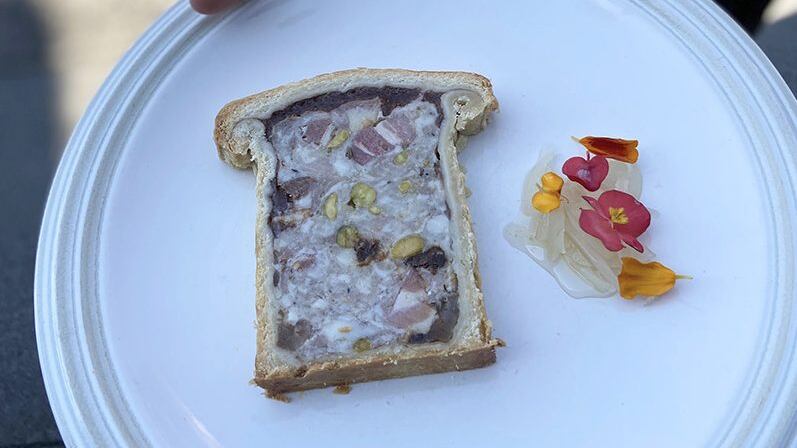Going from Paris to Portland may seem an odd career move for a chef. But for John Denison, it made perfect sense.
After all, this is where his career first took off. In 2014, Denison moved from Colorado to work as a line cook at Kachka. He soon met French-inspired restaurateur Aaron Barnett, and the two bonded over their mutual love for the hearty, rustic cuisine of the Lyonnaise bouchons. That led to Denison's first stint working for Barnett at St. Jack. But in 2015, the owners of Camont, a highly regarded restaurant and cooking school on a farm south of Lyon, came to Portland to teach a butchery and charcuterie class. Denison "begged his way" into a position as the restaurant's butcher, farmhand and, eventually, chef-in-residence.
He then bounced around European kitchens most young cooks can only dream about: working for the Adria brothers at Tickets in Barcelona; at Michelin three-star Les Prés d'Eugénie midway between Toulouse and French Basque Country; then to Paris, where he debuted as head chef at newly opened Ellsworth. When COVID-19 hit, shuttering his restaurant, Denison had a choice: extend his visa and wait out the pandemic in his tiny Parisian apartment or come back home. He chose the latter, reconnecting with Barnett and taking a spot as head chef at La Moule, which Barnett opened on Southeast Clinton Street the year Denison left for Europe.

Originally Barnett's ode to a Belgian moules frites brasserie, La Moule has gradually moved toward a more Gallic orientation since opening in 2015, and it's gone even more in that direction under Denison. One mussel presentation remains: moule marinière flavored with white wine, garlic, Dijon mustard and chile flake ($22), along with the best-in-town bacon and brie burger with fries ($17). But the current menu highlights Denison's French background.
The comté gougères ($11)—two cheesy rounds of baked choux pastry topped with guanciale, more cheese and a chunk of chicharron then sprinkled with espelette powder—are pure bliss. Though it may wander over the stoner food line, a brandade and potato chip-coated variation on the lowbrow scotch egg ($13) is also a small-plate pleasure. And an ever-so-seasonal salad of runner beans, peach slices and hazelnuts in an elderflower vinaigrette ($12) emphasizes the French tradition, adopted enthusiastically here, featuring local produce at its peak.
La Moule is only offering a few large plates these days in its roomy outdoor setup, so check the specials. On my first visit, the albacore collar in a brown butter sauce with capers, olives and pine nuts ($26) was delicious if petite. On the dessert slate, the "peaches 'n' cream" pavlova ($10) is as artistic as it is toothsome, a photogenic assemblage of soft-centered meringue, sliced peaches, dustings of hibiscus powder and black pepper and a scattering of golden flower petals.
But if I had to recommend one dish that best showcases Denison's hard-earned expertise, it would be his ultra-rustic pâté en croûte ($14), a mixture of ground pork—forcemeat or farce in charcutier's vernacular—and other ingredients cloaked in pastry, baked, then chilled and sliced for service. For all its seeming simplicity, it is a three- to four-day production.

LA MOULE’S PÂTÉ EN CROÛTE
The Pastry
Denison begins with a hot water dough, cutting in lard to the basic combination of boiling water and flour. "It creates a strong enough dough to stay flaky on the outside, but holds the fat through the bake," Denison says. The dough is made a day ahead of the pâté.
The Pâté
As with most varieties of pâté, this one is premised on pork. The dish begins with 100% pork belly that is roughly ground and combined with milk and red wine to help bring it together. Some of the belly is set aside and later added to the ground mixture. "First, we cure the pork belly overnight in salt and sugar, then confit it for 12 hours, press it and cool it," Denison says. Next, the meat is cubed and marinated in salt, thyme, quatre epice, garlic and shallots. Internal garnishes also go into the pâté: brandied prunes flambéed in cognac and pistachios together with the pork belly chunks.
The Gelée
Filling the space between pâté and pastry is a savory gelatine. Denison uses marsala wine mixed into the jus from boiled-down pork trotters.
The Assembly
Denison rolls out the dough and refrigerates it while he works on the pâté. "That way," Denison says, "the dough hardens and allows us to press the farce into the molds without compromising the dough. The pressing also gets rid of any air pockets." The pâté en croûte is then baked at 400 degrees. After it is fully cooked, it sits overnight to completely cool and set. The penultimate step is to fill the gaps between meat and crust with the gelée. After another four to six hours to set, this "simple" dish is ready to slice and serve.
EAT: La Moule, 2500 SE Clinton St., 971-339-2822, lamoulepdx.com. 4-9 pm Wednesday-Sunday.

